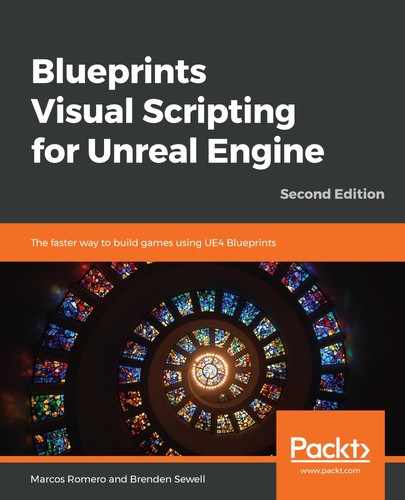Prior to creating a build, or a version of our game that has been optimized to play on a particular platform, you should change the graphics settings of our game to ensure that they are suited to your target machines. The graphics settings in Unreal Engine 4 are identified as Engine Scalability Settings. This setting interface is composed of several graphics settings, each of which determines the final visual quality of one element of the game. With any game, there is a trade-off between high-quality effects and visuals, and the performance of that game in terms of frame rate.
Games that struggle with low frame rates feel bad from a gameplay perspective, even if the mechanics are otherwise solid. As such, it is important to balance the desire to make your game look as good as it can with the need to understand what the performance impact will be on the machines that your players will be running the game on. Because of the varying hardware performance of PCs and macOS computers, many games targeting those platforms use custom menu settings to allow the player to tweak the graphics settings of the game themselves. However, the game we have created only uses very simple assets and a relatively constrained level size, so we are simply going to define some workable defaults before generating a build to distribute.
To access Engine Scalability Settings, go to the FirstPersonExampleMap tab and look at the Level Editor toolbar at the top. Click on the Settings button, and hover over Engine Scalability Settings to see a pop-out display of the Quality settings that you can tweak, as seen in the following screenshot:

The buttons along the top of this menu, ranging from Low to Epic, serve as presets of the settings based on the broad level of performance versus quality that you want to target at runtime. Clicking on the Low button will set all the quality settings to the minimum, giving you the best possible performance, in exchange for the least visually attractive settings. Epic is the opposite end of the spectrum, raising all of the engine quality settings to their maximum, at the sacrifice of significant performance, depending on the assets you have chosen to use.
The Cinematic button will set all the quality settings to cinematic quality, which is used for offline rendering of cinematics only. This setting is not intended for use during gameplay or at runtime.
The Auto button will detect the hardware of the machine you are currently running the Editor on, and adjust the graphics settings to a level that strikes a good balance between performance and a graphical quality that is suitable for your machine. If you are intending to target hardware that is roughly equivalent to the machine you are developing on, using the Auto setting can be a simple way to establish the graphics settings for your build. If you wish to tweak these settings individually, you can use this brief description of their functions to help you:
- Resolution Scale: This setting causes the engine to render the game in a lower resolution than the resolution that your player will be targeting, and uses software to upscale the game to the targeted resolution. This improves the performance of the game, at the cost of perceived fuzziness at lower resolution scales.
- View Distance: This determines the distance from the location of the camera that objects will be rendered. Objects beyond this distance will not be rendered. Shorter view distances increase performance but can cause objects to pop into view suddenly as they cross the view distance boundary.
- Anti-Aliasing: This setting softens the jagged edges of 3D objects in the world, which can dramatically improve the look of your game. At the higher settings, you will see less jagged edges, but it will decrease performance.
- Post Processing: This setting changes the baseline quality settings of several filters that get applied to the screen after the scene is created, such as motion blur and light bloom effects.
- Shadows: This changes the baseline quality of several bundled settings that combine to determine the look of shadows in the game. Highly detailed shadows often have a dramatic impact on performance.
- Textures: This setting will affect the process by which the textures used in your game are managed by the engine. If you have many large textures in your game, reducing this setting can help avoid running out of graphics memory and thus increases performance.
- Effects: This setting changes the baseline quality settings of several special effects applied to the game, such as material reflections and translucency effects.
- Foliage: This setting will affect the quality of foliage used in the game.
Ultimately, the best way of optimizing the performance of your game is to regularly test it on the machines you intend for people to play it on. If you notice sluggish performance, take note of where you see it occur. If the performance of your game is always low, you might need to reduce some of the post-processing or anti-aliasing effects. If performance is low only in certain areas of your level, you might need to look at reducing the object density in that area or reduce the quality of a particular game model.
